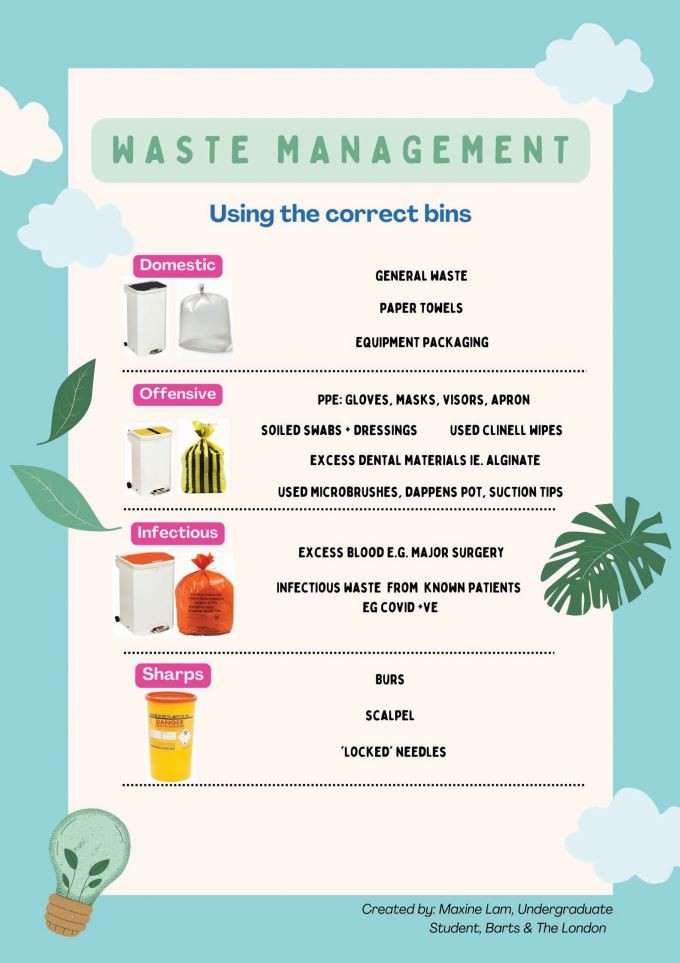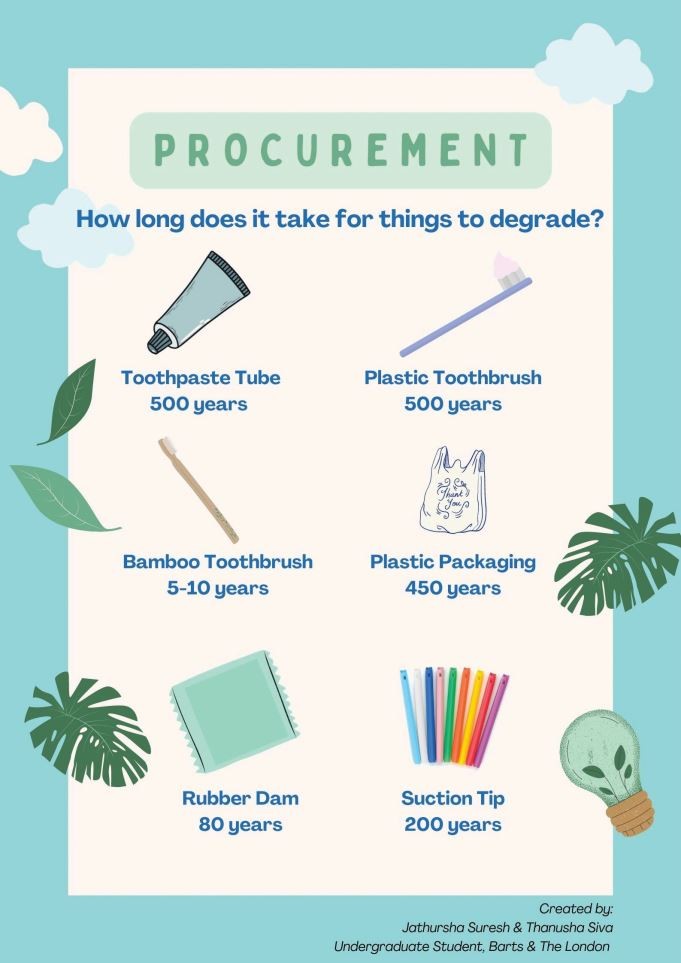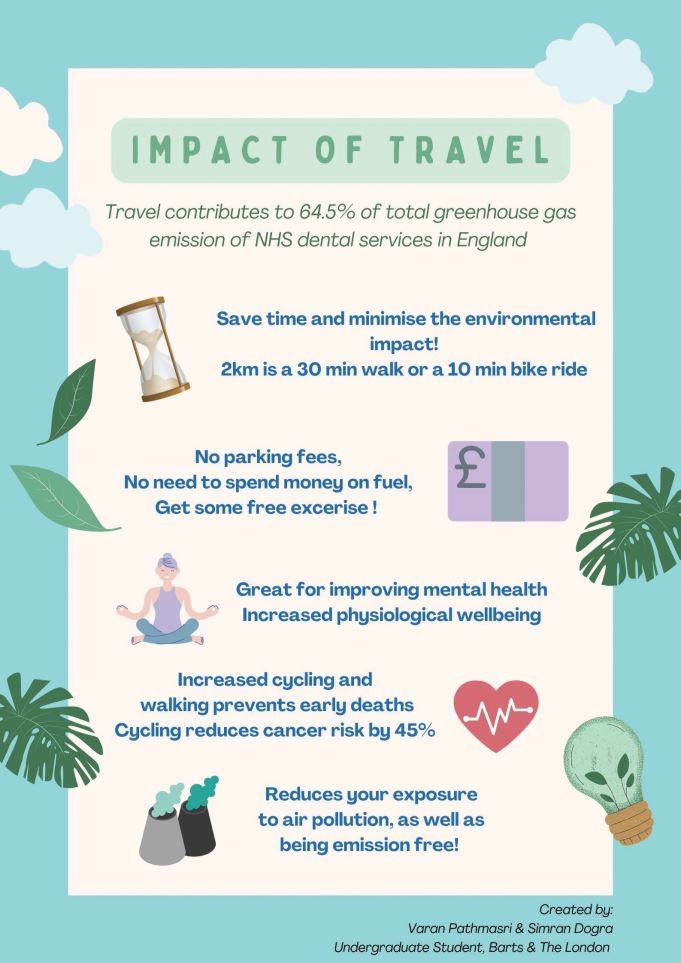
© Mykyta Dolmatov/iStock/Getty Images Plus
Healthcare contributes to approximately 4-5% of the UK's carbon footprint1 (which has driven the NHS' aim to 'be the world's first "net zero" national health service' by 2040, reducing its greenhouse gas emissions by 80%).2 The term 'net zero' refers to an equilibrium between greenhouse gas emission and greenhouse gas removal (eg carbon capture). However, any carbon dioxide (CO2) released remains in the atmosphere for 1,000 years,3 so irrespective of future targets, every tonne of CO2 emissions released today will have an impact on future generations.
Whilst many would think of melting ice caps and extreme weather events, the climate emergency has been referred to as the biggest existential health threat of the twenty-first century; ie the 'climate emergency is a health emergency'.1 The shift in focus results from the growing concern of the multiple health effects of climate change that pose major challenges to health systems globally and include increased risk of cardiorespiratory disease, vector-borne infections, adverse pregnancy outcomes, and impaired cognitive-motor function, with those who face health inequalities at the greatest risk.4 More recently, we have seen how this can also have a local impact, following the flooding of a London Hospital, after which patients had to be evacuated.5
It has been estimated that primary dental services have a carbon footprint of 675 kilotonnes of carbon dioxide equivalents,6 so there is massive scope for us to implement system-wide change to make a real difference. These top tips will help you reduce the environmental burden of your dental care without compromising clinical outcomes, patient experience or quality.
-
1.
Reduce waste

The past decade has seen a shift towards single use disposable dental instruments and personal protective equipment (PPE) and the environmental implications are huge. Plastics comprise 22.7% of the waste generated within the NHS, generating a phenomenal 133,000 tonnes annually, with only a 5% recovery rate.7
An understanding of waste streams is paramount to reducing incorrect disposal, which can be both costly and energy-intensive.8
For clinical waste, consider conducting waste management audits to ensure that staff are placing waste in the correct bins. For example, the packaging for PPE can be placed in domestic waste or recycled where possible which has a lower environmental impact than placing in offensive waste streams (Table 1).
Make recycling more accessible for staff and patients by placing recycling bins in the reception area. Currently, 300 million tubes of toothpaste go to landfill per year in the UK9 so a TerraCycle bin for used tubes and toothbrushes can help to combat this.
Where possible, go paperless for clinical notes, patient information leaflets, consent forms and appointment cards.
When wearing PPE, consider the following: do I need to wear it in this particular situation? Is the level of PPE correct for the procedure intended? The 'gloves off' campaign highlighted the over and unnecessary use of gloves and their impacts globally, ranging from the unethical treatment of factory workers producing them, the increase in dermatitis and the spread of infections due to poor hand hygiene; this is in addition to the environmental impacts.10
Consider the use of reusable PPE such as reusable type IIR masks, gowns, draping and surgical hats - all of which are currently available on the market and comply with specifications necessary for infection prevention control (IPC). You can also look into using reusable sharps bins eg, Stericycle which can be reused up to 600 times.
Whilst recycling can reduce the environmental impact of the waste we produce it is an inefficient process with recycled plastics being of poorer quality and our focus should be on reducing the amount of waste we produce.
-
2.
Procure more sustainable products

The best way to assess the sustainability of a product is by analysing its life cycle assessment (LCA). This looks at the carbon footprint of a product at various stages: from raw material to manufacturing, procurement, shipping and disposal. An example of this is the use of gloves: surgical sterile gloves (ones in packaging) carry a considerable environmental burden compared to non-sterile gloves (ones in boxes)11 so careful selection appropriate to the procedure is warranted.
Encourage the use of sustainable toothbrushes and oral hygiene aids. The use of electric toothbrushes has an 11-fold greater climate impact than a bamboo toothbrush.12 Manual toothbrushes are available on the market where heads can be replaced and offer a good long-term alternative. Toothpaste tablets are becoming readily available and are largely plastic free.
Reduce plastics and single use items where possible. Incinerating plastics produces the most harmful emissions as not only is CO2 produced but toxic gases, dioxins are also generated.
As a profession, we have consumer power and should be asking our suppliers to engage in 'greener' products, manufacturing processes (eg using renewable energy sources or manufacturing more locally) and delivery of items (eg via cargo or electric bikes). Engage with your local dental supplier and ask about the products in their 'green' range, such as biodegradable suction tips and barrier coverings.
-
3.
Reduce travel, promote active travel and become more energy efficient

The highest proportion of emissions due to dentistry in the UK came from travel, procurement, energy, and nitrous oxide. Approximately 3.5% of all road travel in England is due to healthcare-related excursions.2 Electric vehicles may be emission-free but the manufacturing and extraction of elements such as lithium carry a carbon footprint. The most sustainable mode of transportation is cycling, running or walking, known as active travel.
Active travel not only reduces carbon emissions but also the prevalence of obesity, diabetes and cardiovascular disease.1 We can also encourage staff and patients to travel to their appointment through sustainable travel options such as walking or cycling by providing secure cycle racks.
Aim to reduce the number of times patients need to attend the dental practice by triaging appropriately, utilising virtual appointments, grouping treatments and providing long-lasting, low-maintenance treatments. Ensuring we 'Get it right first time' (GIRFT) will also minimise repeated unnecessary visits.
-
4.
Education
As health care professionals, we are in a prime position to increase awareness and educate our teams and patients on the health effects of climate change. Here are a few tips:
-
Try incorporating sustainability education into practice development and CPD days. When presenting seminars, workshops or lectures, include the importance of sustainability as part of the holistic approach to care
-
A carbon literacy toolkit is available and provides healthcare professionals with the resources needed to engage staff and help deliver climate education. This toolkit is free and can be requested via https://carbonliteracy.com/toolkits/healthcare/
-
Encourage staff to make pledges to change their practice and lifestyle to reduce their carbon footprint and incentivise staff to participate by offering sustainable prizes for those who adhere to their pledges
-
For those who work in secondary care or community dental services, find out about your trust's green plans which is especially useful to those wishing to implement sustainable initiatives as there may be access to funding and support via central sustainability teams.
The Centre for Sustainable Health has an abundance of valuable resources in their guide, Sustainable dentistry: how-to guide for dental practices and offer dedicated dental sustainability CPD: https://sustainablehealthcare.org.uk/dental-guide.
-
5.
Prevention
An upstream approach to the prevention of dental disease will likely have the biggest impact. Preventing dental caries or periodontal disease allows a reduction in patient recalls, travel and material use. Patients with heavily restored dentitions have a greater carbon footprint than those who have required no treatment.
Cessation advice relating to lifestyle habits such as smoking and alcohol intake can be massively impactful in reducing the environmental footprint when considering their consequences relating to oral cancers, periodontal disease and delayed healing post-surgery.
Ensuring we follow the Delivering better oral health toolkit13 for all of our patients will reduce their risk of dental disease. For patients with high risk of dental decay, ensure that high-fluoride toothpaste and fluoride mouthwash is prescribed where appropriate. Diet advice and oral hygiene instructions also help to reduce the risk of dental disease, thus directly helping to reduce the carbon footprint of our patients' care.
-
6.
Inhalation sedation and anaesthetic gases
The contribution of anaesthetic gases to the environmental footprint has gained widespread attention. With particular relevance to dentistry is nitrous oxide, which constitutes roughly 6% of greenhouse emissions and has a lifespan of over 100 years.14 Reducing leakages from hospital manifolds and gas capturing technology (eg Medclair's mobile destruction unit) could help cut NHS anaesthetic emissions. This technology can also be applied for the use of conscious sedation. However, nitrous oxide catalysing technologies are only just being piloted within dentistry in the UK, and come with a hefty price tag.
Where possible, patients should be supported to manage their dental treatment with local anaesthetic alone which has a much lower environmental impact. Patients with anxiety can be supported in secondary care, with the help of psychologists. This allows them to learn mindfulness techniques and undergo cognitive behavioural therapy to improve their compliance for treatment.
-
7.
Go digital
The COVID-19 pandemic has transformed communication within the health sector. The uptake of virtual appointments boomed, with 3 million virtual patient contacts made over a one-year period within NHS services15 preventing 14.2k tonnes of carbon emissions. Digitisation is very cost effective and climate efficient.
Trying to implement the use of intra-oral scanners for impression taking reduces material usage and waste production; this also reduces CO2 emissions from transportation to labs.
Virtual consultations reduce the need for patients to travel for appointments and in turn reduces amount of PPE, instruments and materials used. It is also more cost effective for patients as it reduces money spent on travel, car parking and care for dependants.
Virtual CPD reduces travel and the carbon footprint associated with resources such as handouts, registrations and catering.
Conclusion
Urgent and drastic action is required to tackle the contribution of dental care to the climate emergency which undermines general health. Protecting and maintaining the health of patients should be at the forefront of our profession's direction, which emphasises the need to embed sustainability into clinical practice.
References
Watts N, Amann M, Arnell N et al. The 2019 report of The Lancet Countdown on health and climate change: ensuring that the health of a child born today is not defined by a changing climate. Lancet 2019; 394: 1836-1878.
NHS England. Delivering a net zero NHS. Available at: https://www.england.nhs.uk/greenernhs/a-net-zero-nhs/ (accessed August 2022).
Buis A. The Atmosphere: Getting a Handle on Carbon Dioxide. Global Climate Change: Vital Signs of the Planet. 9 October 2019. Available at: https://climate.nasa.gov/news/2915/the-atmosphere-getting-a-handle-on-carbon-dioxide/ (accessed August 2022).
Watts N, Adger W, Agnolucci P et al. Health and climate change: policy responses to protect public health. Lancet 2015; 386: 1861-1914.
Wedmore F. Florence Wedmore: This is climate breakdown, and it is having a real effect on our patients. 12 August 2021. Available at: https://blogs.bmj.com/bmj/2021/08/12/florence-wedmore-this-is-climate-breakdown-and-it-is-having-a-real-effect-on-our-patients/ (accessed August 2022).
Duane B, Lee M, White S, Stancliffe R, Steinbach I. An estimated carbon footprint of NHS primary dental care within England. How can dentistry be more environmentally sustainable? Br Dent J 2017; 223: 589-593.
Percival A. Not so fantastic plastic. 12 October 2019. Available at: https://nhsproviders.org/news-blogs/blogs/not-so-fantastic-plastic (accessed August 2022).
NHS. COVID-19 waste management standard operating procedure. Version 4. 18 January 2021. Available at: https://www.england.nhs.uk/coronavirus/wp-content/uploads/sites/52/2021/01/C0995-covid-19-waste-management-guidance-sop-v4.pdf (accessed August 2022).
BDJ News. 300 million toothpaste tubes go to landfill. Br Dent J 2021; 230: 390.
Strain D. When the gloves come off. 6 May 2022. Available at: https://www.bma.org.uk/news-and-opinion/when-the-gloves-come-off (accessed August 2022).
Jamal H, Lyne A, Ashley P, Duane B. Non-sterile examination gloves and sterile surgical gloves: which are more sustainable? J Hosp Infect 2021; 118: 87-95.
Lyne A, Ashley P, Saget S, Porto Costa M, Underwood B, Duane B. Combining evidence-based healthcare with environmental sustainability: using the toothbrush as a model. Br Dent J 2020; 229: 303-309.
Office for Health Improvement and Disparities, Department of Health and Social Care, NHS England, NHS Improvement. Delivering better oral health: an evidence-based toolkit for prevention. Updated 21 September 2021. Available at: https://www.gov.uk/government/publications/delivering-better-oral-health-an-evidence-based-toolkit-for-prevention (accessed August 2022).
MassonDelmotte V P, Zhai A, Pirani S L et al. IPCC, 2021: Summary for Policymakers. In Climate Change 2021: The Physical Science Basis. Contribution of Working Group I to the Sixth Assessment Report of the Intergovernmental Panel on Climate Change. pp 3-32. Cambridge (UK), New York (USA): Cambridge University Press, 2021.
Edge Health. Video Consultations in Secondary Care. September 2021. Available at: https://50c9e2c4-52c0-446c-ba2a-d30d413979a1.filesusr.com/ugd/80447b_6de17e20b060409a8c8f937312f43375.pdf (accessed August 2022).
Author information
Authors and Affiliations
Rights and permissions
About this article
Cite this article
Shehabi, Z., Booth, J. & Revert, B. Top tips for making your practice more environmentally sustainable. Br Dent J 233, 252–254 (2022). https://doi.org/10.1038/s41415-022-4938-7
Published:
Issue Date:
DOI: https://doi.org/10.1038/s41415-022-4938-7



